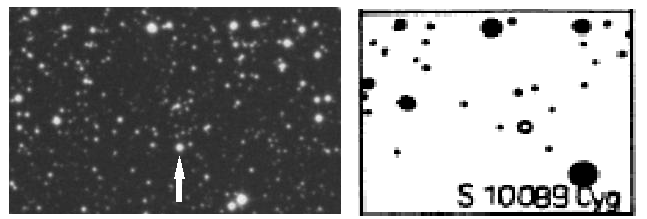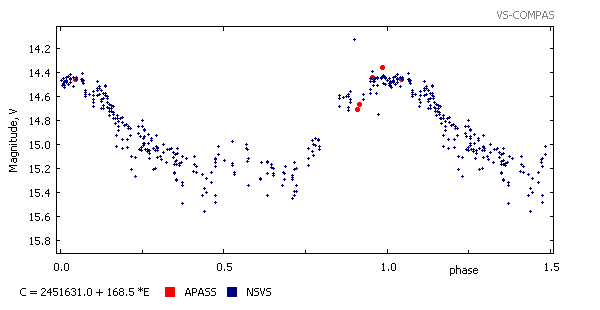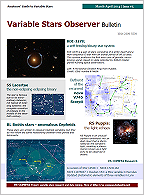Variable Stars Common Observation
Mission in Particular Areas of the Sky
NSV 13636 Classification Revised
 by Ivan Adamin in
July-August 2013 (#1)
by Ivan Adamin in
July-August 2013 (#1) Being initially referenced by C.Hoffmeister as S 10089 Cyg, a long-periodic suspect, the NSV 13636 was finally resolved to SRA variable with period of 168.5 days.
The NSVS 5897136 photometric data set was initially pointed out by Ivan Adamin as the red object worth to revise back in 2012.
| NSV 13636 (SRA) | |
|---|---|
| AAVSO UID: | 000-BLC-565 |
| Constellation: | Cygnus |
| J2000.0: | 21 16 54.19 +41 33 56.1 |
| Mag. range: | 14.4 - <15.4 V |
| Epoch: | HJD 2451631.0 (27 Mar 2000) |
| Period: | 168.5 days |
Hoffmeister, in his "Mitteilungen uber neuentdeckte Veranderliche Sterne" (1967), referenced the object called S 10089 Cyg (J1855.0: RA = 21h 11.4m; DEC = +40° 58') as a long-period variable, but no precise type or period were declared. Though there was a finding chart published in the same paper, related to the "Field 20h58m+44°" (Epoch 1855.0) in Cygnus, which is quite close to the famous planetary nebula NGC 7027.

Hoffmeister's finding chart for S 10089 Cyg (right).
and the DSS chart for NSV 13636 (left)
Comparing Hoffmeister's chart with the DSS plate for the mentioned region one can unambiguously figure out that S 10089 Cyg, NSVS 5897136 and NSV 13636 is exactly the same object referenced by different names.

Periodogram for the NSV 13636 data.
A period search was performed on the NSVS data by Siarhey Hadon (VS-COMPAS project). Calculated periodogram has a strong peak around 168.5 days. This period has a good match with a contemporary data from the APASS survey, conducted by the AAVSO.
Moreover, APASS data was obtained around the maximum brightness, giving a good match with the NSVS photometry. The star is in highly populated area in Cygnus, means there are some close neighbors around contaminating the light for wide-angle optics.

NSV 13636 in Cygnus. Period is 168.5 days.
by Ivan Adamin, Siarhey Hadon (VS-COMPAS)
Particularly, the NSVS magnitudes of are contaminated by the following stars:
1) 2MASS J21165325+4133591 (J-K= 1.59, V= 17.1, sep. 9")
2) 2MASS J21165635+4134093 (J-K= 0.24, V= 16.6, sep. 27")
3) 2MASS J21165663+4133582 (J-K= 0.28, V= 17.5, sep. 28")
4) 2MASS J21165651+4134144 (J-K= 0.71, V= 17.5, sep. 32")
To get the real magnitude range, there was a deblending method applied to the light curve data. This is allowed to get a better estimate for the minima. The VSX record for NSV 13636 was updated with the new data, so NSV 13636 joined the ranks of known variable stars.
This is a good candidate to complement the list of 177 other NSV records listed in the "Confirmation of 177 objects in the New Suspected Variables Catalogue as red long period variables" (Greaves, 2006), though Greaves processed ASAS3 time series data. NSV 13636 was not covered by ASAS3 survey, unfortunately.
Free Bulletin on Variable Stars
Variable Stars Observer Bulletin is all about variable stars science. It's made by amateurs and for amateurs. Here simplified contemporary data about different aspects of variable stars research is published. The bulletin is scheduled for six issues per year.
Want to contribute an article? Feel free to contact us at:
http://www.vs-compas.belastro.net/bulletin-contribute
or please simply drop an email to [ivan dot adamin at gmail dot com]
 Issue #5
Issue #5
March-April 2014
Free Online
PDF Bulletin on Variable Stars
Amateurs' Guide to Variable Stars
Read Online as e-Magazine
In this issue:
 by Ivan Adamin
by Ivan Adamin
BL Bootis stars - anomalous Cepheids
 by Ivan Adamin
by Ivan Adamin
A revision of NSV 13538 = NSVS 17231162
 by Alexandr Ditkovsky
by Alexandr Ditkovsky
NSVS 11075037 = Dauban V53:
updated elements of a Mira variable in Hercules
 by Siarhey Hadon
by Siarhey Hadon
Pulsating variable stars and the Hertzsprung-Russell diagram
 by Siarhey Hadon, Ivan Adamin
by Siarhey Hadon, Ivan Adamin
RS Puppis: the light echoes calibrate standard candles for accurate distance measurements
 by Ivan Adamin
by Ivan Adamin
SS Lacertae: The non-eclipsing eclipsing binary
 by Ivan Adamin
by Ivan Adamin
>>View Full Contents

|
Statistics Overview
Variables by Type Variables by Magnitude Variables by Period Build Own Criteria |
